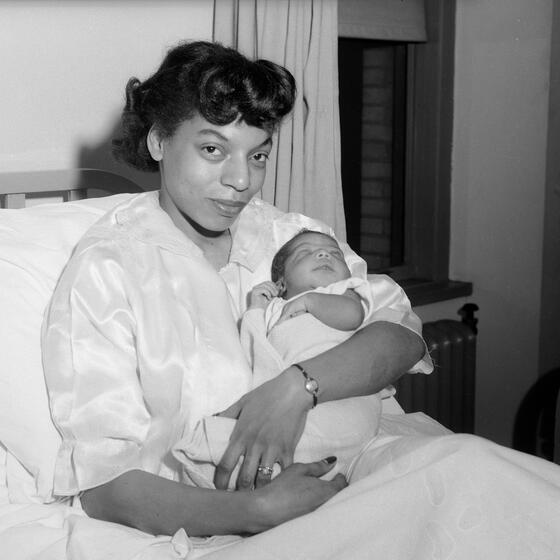Study Finds Hospital Desegregation Didn’t Improve Mortality Rate for Black Infants
In the late 1960s, the federal government took strong steps to desegregate hospitals in the American South. A new study co-authored by Dean Kerwin Charles finds that these efforts did not significantly contribute to improvements in the Black infant mortality rate.

Charles ‘Teenie’ Harris/Teenie Harris Archive/Carnegie Museum of Art/Getty Images.
A new paper co-authored by Yale SOM Dean Kerwin K. Charles reassesses efforts to desegregate Southern hospitals in the 1960s and finds that they did not significantly improve health outcomes for Black Americans. The findings of this new analysis, which focuses on the effects of desegregation on the Black infant mortality rate, call into question the assumption that desegregation on its own improved healthcare for Black Americans and point to the need for deeper change when addressing racial inequities.
Prior to the signing of the Civil Rights Act of 1964, most hospitals in the South remained segregated by race, and many hospitals that treated both Black and White Americans assigned inferior facilities to Blacks. While the act broadly outlawed discrimination based on race, many hospitals did not immediately comply. In 1966, the creation of Medicare promised significant new federal spending on healthcare, and the Johnson Administration decreed that hospitals that failed to desegregate in compliance with the Civil Rights Act would not be eligible to receive such funds. Hospitals would have to be certified by the Office of Equal Health Opportunity before they could receive Medicare payments. OEHO inspectors fanned out across the country, and most hospitals came into compliance.
This desegregation effort has been frequently lauded, but Charles and his co-authors—D. Mark Anderson of Montana State University and Daniel I. Rees of the University of Colorado Denver—point out, “We do not know a great deal about the relationship between hospital desegregation and health.” The one existing study on the topic looked at the Black infant mortality rate in Mississippi and seemed to find substantial improvements over the period of hospital desegregation. But by looking at results across five Southern states and more carefully parsing what happened as their residents gained access to a Medicare-eligible (and thus desegregated) hospital, the authors of the new paper sought to distinguish the effect of desegregating hospitals from the broader trend of improvement in Black infant mortality rate (IMR).
Not only did the Black IMR improve over the period 1959-73, but it improved relative to the White rate, closing some of the Black-White gap. Charles and his co-authors point out that there were a number of factors driving this trend beside hospital desegregation. Black Southerners were making “significant economic progress both in absolute terms and relative to Whites throughout the 1960s.” In addition, the implementation of other health programs, such as state Medicaid programs, could have led to improved health outcomes.
“Our results suggest that correcting overtly discriminatory practices on the part of Southern hospitals was simply not enough to ensure that Black infants experienced the same health outcomes as their White counterparts.”
Charles and his coauthors took advantage of the fact that OEHO inspectors certified hospitals over several years to examine how much of the improvement in Black IMR was due to hospital desegregation. Their analysis used county-level data that enabled them to calculate when patients in a given county gained access to a Medicare-eligible hospital and to look at corresponding changes in the Black IMR in that area. They found that it is unlikely that hospital desegregation reduced Black IMR or helped close the difference in Black-White IMR.
The researchers also looked specifically at mortality from pneumonia/influenza and diarrhea, two preventable causes of death, and found no evidence that access to a desegregated hospital reduced mortality rates from those causes. The paper also considers whether the desegregation efforts led more Black mothers to choose to give birth in the hospital. They find that hospital desegregation may have made a small contribution to the trend toward more in-hospital births.
Why didn’t the desegregation of hospitals, which presumably made the same facilities available to people of all races, do more to eliminate the gap between Black and White infant mortality rates? Charles and his coauthors note that the OEHO investigators who initially certified hospitals as being compliant with the Civil Rights Act looked primarily at whether patients were assigned to hospital rooms, wards, and caregivers “without regard to race, color, or national origin.” The inspectors did not consider the structural barriers and cultural biases that prevented Black patients from receiving quality care. While overt segregation was largely stamped out, many subtler forms of discrimination persisted. “Our results suggest that correcting overtly discriminatory practices on the part of Southern hospitals was simply not enough to ensure that Black infants experienced the same health outcomes as their White counterparts,” write the authors. This conclusion, they add, is consistent with the argument made by some scholars that punitive measures may not prove effective at reducing discrimination if they do not also address underlying biases and prejudices.
The authors note that their study doesn’t assess the long-term effects of hospital desegregation. And, while the Black-White IMR gap has shrunk in some states, it remains significant, and an indication of ongoing disparities in healthcare that require further study and deeper understanding.